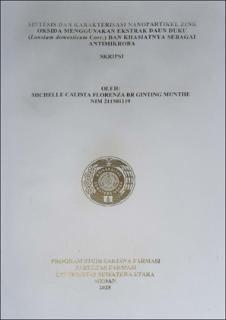| dc.description.abstract | Background: Antimicrobial resistance in developing countries, including
Indonesia, is a serious threat and is expected to surpass cancer as the leading cause
of death by 2050. This study synthesized zinc oxide nanoparticles (ZnO-NPs) using
the green synthesis method with duku (Lansium domesticum Corr.) leaf extract,
which is rich in polyphenols and flavonoids. The resulting ZnO-NPs were
characterized and tested for antimicrobial activity.
Objective: This research aimed to synthesize and evaluated the antimicrobial
activity of zinc oxide nanoparticles using duku leaves aqueous extract.
Methods: The aqueous extract of duku leaves was prepared by the infudation
method, then mixed with zinc nitrate solution with a variation of the ratio of 0.5:10;
1:10, 1.5:10 and 2; 10 and then added NaOH, as a pH regulator to optimize particle
formation conditions. ZnO-NPs with the highest percent yield were characterized
for absorbance peak, particle size, functional groups, structural analysis,
morphology, crystal purity and particle thermal stability and tested for biological
activity against several microbes, namely Escherichia coli, Staphylococcus aureus,
and Staphylococcus epidermidis as well as Candida albicans
Results: ZnO-NPs with the highest percent yield (35.30%) were characterized
using various techniques: SEM and TEM showed a spherical hexagonal crystal
structure, EDS confirmed the elemental purity of Zn and O, and DSC-TGA showed
thermal stability with a phase transition at 302.64°C. UV-Vis absorption peaks
appeared at 362 nm, PSA measured an average particle size of 294 nm, FTIR
identified Zn-O groups at 873, 670, and 507 cm-¹, while XRD estimated a crystal
size of 43.25 nm. ZnO-NPs exhibited high antimicrobial activity against
Staphylococcus aureus, Staphylococcus epidermidis, Escherichia coli, and
Candida albicans, with zones of inhibition of 13.76 ± 0.56 mm, 15.8 ± 0.81 mm,
15.8 ± 0.81 mm, and 11.96 ± 0.25 mm, respectively.
Conclusion: Duku leaves extract was utilized in the synthesis process of ZnO-NPs,
and the resulting ZnO-NPs exhibited activity against the test bacteria and fungi
used. | en_US |


